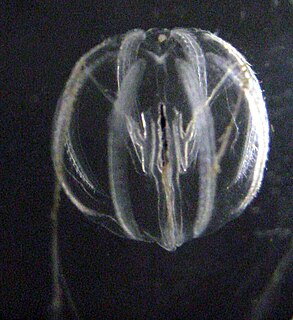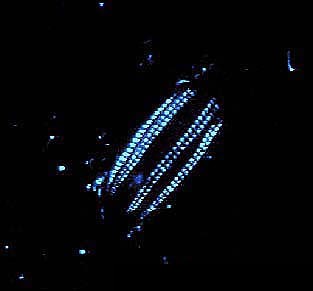
An axon, or nerve fiber, is a long, slender projection of a nerve cell, or neuron, in vertebrates, that typically conducts electrical impulses known as action potentials away from the nerve cell body. The function of the axon is to transmit information to different neurons, muscles, and glands. In certain sensory neurons, such as those for touch and warmth, the axons are called afferent nerve fibers and the electrical impulse travels along these from the periphery to the cell body and from the cell body to the spinal cord along another branch of the same axon. Axon dysfunction can cause many inherited and acquired neurological disorders which can affect both the peripheral and central neurons. Nerve fibers are classed into three types – group A nerve fibers, group B nerve fibers, and group C nerve fibers. Groups A and B are myelinated, and group C are unmyelinated. These groups include both sensory fibers and motor fibers. Another classification groups only the sensory fibers as Type I, Type II, Type III, and Type IV.

Cnidaria is a phylum under kingdom Animalia containing over 11,000 species of aquatic animals found both in freshwater and marine environments, predominantly the latter.

A nerve is an enclosed, cable-like bundle of nerve fibers in the peripheral nervous system.

A squid is a mollusc with an elongated soft body, large eyes, eight arms, and two tentacles in the superorder Decapodiformes. Like all other cephalopods, squid have a distinct head, bilateral symmetry, and a mantle. They are mainly soft-bodied, like octopuses, but have a small internal skeleton in the form of a rod-like gladius or pen, made of chitin.

Ctenophora comprise a phylum of marine invertebrates, commonly known as comb jellies, that inhabit sea waters worldwide. They are notable for the groups of cilia they use for swimming, and they are the largest animals to swim with the help of cilia.

A nerve net consists of interconnected neurons lacking a brain or any form of cephalization. While organisms with bilateral body symmetry are normally associated with a condensation of neurons or, in more advanced forms, a central nervous system, organisms with radial symmetry are associated with nerve nets. Nerve nets can be found in members of the Ctenophora, Cnidaria, and Echinodermata phyla, all of which are found in marine environments. Nerve nets can provide animals with the ability to sense objects through the use of the sensory neurons within the nerve net.

In zoology, a tentacle is a flexible, mobile, and elongated organ present in some species of animals, most of them invertebrates. In animal anatomy, tentacles usually occur in one or more pairs. Anatomically, the tentacles of animals work mainly like muscular hydrostats. Most forms of tentacles are used for grasping and feeding. Many are sensory organs, variously receptive to touch, vision, or to the smell or taste of particular foods or threats. Examples of such tentacles are the eyestalks of various kinds of snails. Some kinds of tentacles have both sensory and manipulatory functions.

The caridoid escape reaction, also known as lobstering or tail-flipping, refers to an innate escape mechanism in marine and freshwater crustaceans such as lobsters, krill, shrimp and crayfish.

The squid giant axon is the very large axon that controls part of the water jet propulsion system in squid. It was first described by L. W. Williams in 1909, but this discovery was forgotten until English zoologist and neurophysiologist J. Z. Young demonstrated the axon's function in the 1930s while working in the Stazione Zoologica in Naples, the Marine Biological Association in Plymouth and the Marine Biological Laboratory in Woods Hole. Squids use this system primarily for making brief but very fast movements through the water.
The lateral giant interneuron (LG) is an interneuron in the abdominal nerve cord of crayfish, lobsters, shrimp of the order Decapoda and their relatives in the crustacean class Malacostraca. It is part of the system that controls a special kind of escape reflex of these organisms known as the "caridoid escape reaction."

The longfin inshore squid is a species of squid of the family Loliginidae.
William Frank Gilly is an American biologist specializing in the study of cephalopods. He works at Gilly Lab, Hopkins Marine Station, in Monterey County, as a professor of biology, at Stanford University and was involved with the television special The Future is Wild.
The Mauthner cells are a pair of big and easily identifiable neurons located in the rhombomere 4 of the hindbrain in fish and amphibians that are responsible for a very fast escape reflex. The cells are also notable for their unusual use of both chemical and electrical synapses.

Cydippida is an order of comb jellies. They are distinguished from other comb jellies by their spherical or oval bodies, and the fact their tentacles are branched, and can be retracted into pouches on either side of the pharynx. The order is not monophyletic, that is, more than one common ancestor is believed to exist.

Pleurobrachia bachei is a member of the phylum Ctenophora and is commonly referred to as a sea gooseberry. These comb jellies are often mistaken for medusoid Cnidaria, but lack stinging cells.

Beroe, commonly known as the cigar comb jellies, is a genus of comb jellies in the family Beroidae. Beroe exhibits bioluminescence.

Beroe cucumis is a species of comb jelly in the family Beroidae. It is found in the Atlantic Ocean. It was first described by the Danish missionary and naturalist Otto Fabricius in 1780.
Ganesha is a genus of comb jellies. It is the only genus in the monotypic family Ganeshidae and the order Ganeshida. They are characterized by pair of small lobes round the mouth, and extended pharynx. Two species are currently recognized: Ganesha elegans and Ganesha annamita.

Aglantha digitale is a species of hydrozoan in the family Rhopalonematidae. It is found in the Arctic and sub-Arctic where it is one of the most common jellyfish. It is unusual in having both a slow swimming action, through pulsating its bell, and a rapid escape response.

Euplokamis is a genus of ctenophores, or comb jellies, belonging to the monotypic family Euplokamididae. Despite living for hundreds of millions of years in marine environments, there is minimal research regarding Euplokamis, primarily due to their body structure. Research on the evolution of the basic body structures of diploblastic metazoans revealed that there are four major phyla, including the Ctenophores. Although the morphology of Euplokamis often resembles the medusa stage of Cnidarians, their eight rows of combs are one distinguishing feature that led to the official classification of Ctenophores. After being originally described by Chun (1879), the family Euplokamididae was expanded by Mills (1987) due to the discovery of a new species, Euplokamis dunlapae. Further research indicated that Euplokamis should be identified from Mertensiidae due to the rows of combs and some compression. They may also be distinguished from the genus Pleurobrachia due to their more elongated shape. Additionally, various adaptations of Euplokamis have been observed such as the use of tentacles for movement/feeding, a complex nervous system, and bioluminescent capabilities. Other characteristics including a defined mesoderm, lack of stinging cells, developmental differences, and symmetry supported the reclassification of these organisms.















